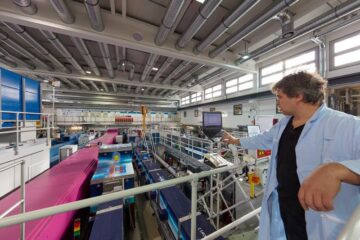New Recombinant Production of Design Rhamnolipids – Optimized Biosurfactant Fermentation Process

Biosurfactants have attracted increasing interest since they show a number of advantages over surfactants of petrochemical origin in terms of ecological acceptance, low toxicity and sustainability. Biosurfactants also have a huge application potential, for example in chemical and pharmaceutical industry or as emulsifier in cosmetics and foods.
Among the best established biosurfactants are the rhamnolipids. Rhamnolipids are glycosides with one (mono-rhamnolipid) or two rhamnose-units (di-rhamno-lipid) as the glycon portion and one to three β-hydroxy-fatty acid moieties as the aglycon portion. Rhamnolipids are naturally produced by two rhamnosyl-transferases encoded by rhlA, rhlB and rhlC by the opportunistic pathogen Pseudomonas aeruginosa. The rhlA and rhlB genes form an operon, encoding subunits A and B of rhamnosyltransferase 1, while rhlC encodes rhamnosyltransferase 2. In particular, the present invention provides a genetically modified non-pathogenic host cell that may be employed for production of favoured rhamnolipids in high yields. Use of the modified host cell allows selective production of various rhamnolipids, e.g. mono- or dirhamnolipids and a various length of fatty acids. As a first example, a bacterial host cell includes a rhlA gene, a rhlB gene or orthologs thereof. The genes are under the control of a heterologous promoter. In a further embodiment, the host cell may preferably also contain a rhlC gene, or an ortholog thereof. The biotechnical production process is in addition optimized at varying temperature conditions.
Weitere Informationen: PDF
PROvendis GmbH
Tel.: +49 (0)208/94105 10
Ansprechpartner
Dipl.-Ing. Alfred Schillert
Media Contact
Alle Nachrichten aus der Kategorie: Technologieangebote
Neueste Beiträge

Bakterien für klimaneutrale Chemikalien der Zukunft
Forschende an der ETH Zürich haben Bakterien im Labor so herangezüchtet, dass sie Methanol effizient verwerten können. Jetzt lässt sich der Stoffwechsel dieser Bakterien anzapfen, um wertvolle Produkte herzustellen, die…

Batterien: Heute die Materialien von morgen modellieren
Welche Faktoren bestimmen, wie schnell sich eine Batterie laden lässt? Dieser und weiteren Fragen gehen Forschende am Karlsruher Institut für Technologie (KIT) mit computergestützten Simulationen nach. Mikrostrukturmodelle tragen dazu bei,…

Porosität von Sedimentgestein mit Neutronen untersucht
Forschung am FRM II zu geologischen Lagerstätten. Dauerhafte unterirdische Lagerung von CO2 Poren so klein wie Bakterien Porenmessung mit Neutronen auf den Nanometer genau Ob Sedimentgesteine fossile Kohlenwasserstoffe speichern können…

















